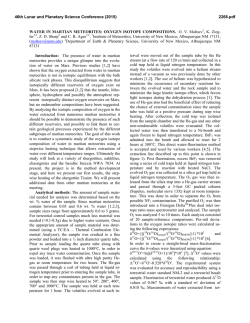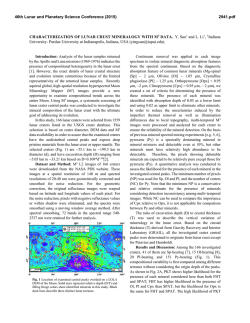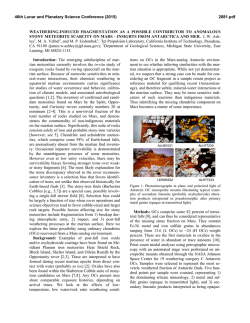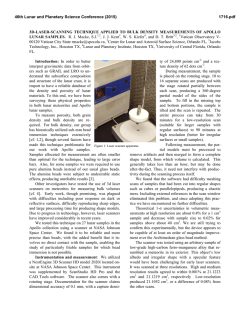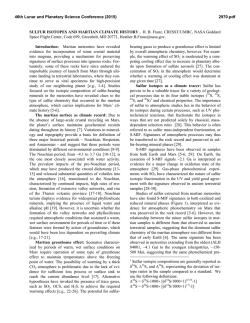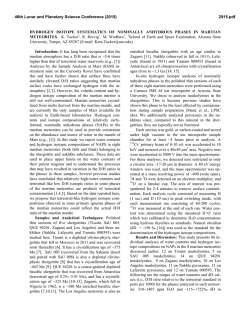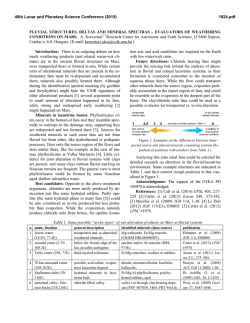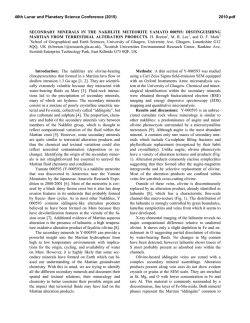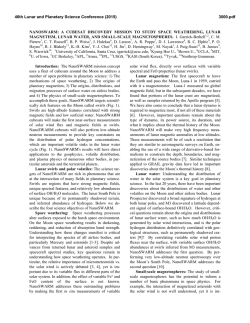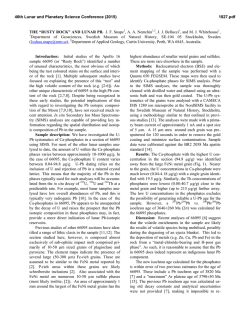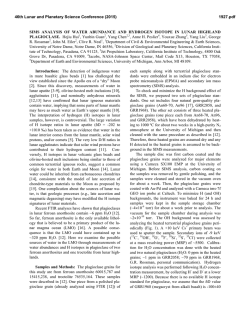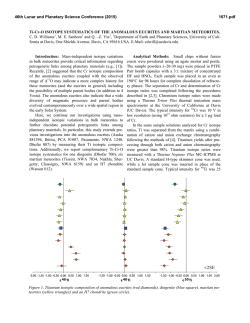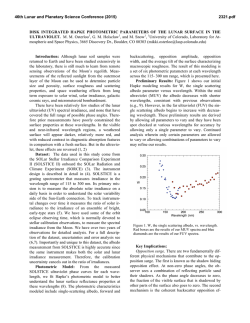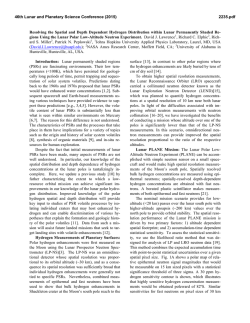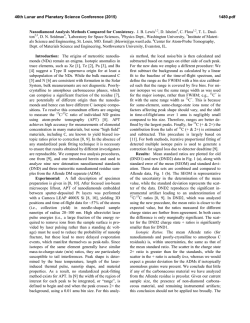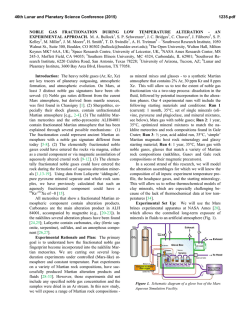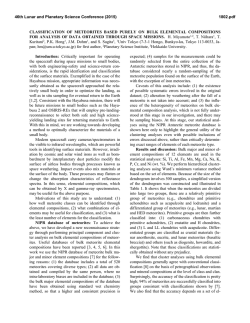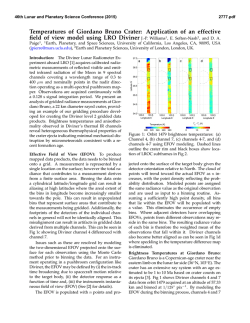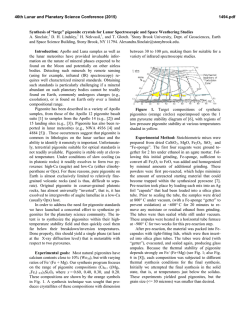
2288
46th Lunar and Planetary Science Conference (2015) 2288.pdf INVESTIGATIONS OF SHOCK EFFECTS ON PHOSPHATE MINERALS IN EXTRATERRESTRIAL MATERIALS. C. T. Adcock1, E. M. Hausrath1, O. Tschauner1, and A. Udry1, 1University of Nevada, Las Vegas, 4505 S. Maryland Pkwy, Las Vegas, Nevada 89154. [email protected] Introduction: Phosphate minerals have significant importance to planetary studies. They are indicators of magma evolution and volatile budgets in late stage magmas [1-7]. They are also important in martian astrobiological studies as the source of potentially bioessential P [8], and altered or secondary phosphate minerals can be used as indicators of past surface and near surface aqueous environments and water budgets on Mars [9]. However, our only samples of extraterrestrial phosphate minerals are in meteorites (including martian and lunar) and lunar samples. All meteorites, including those from Mars and the Moon, have experienced shock. Lunar samples returned from the Moon have also been subjected to differing degrees of shock and potential alteration. Any interpretation based on petrographic evidence from meteorites must therefore take into account the potential alteration of minerals by shock and associated heating. The broad goal of this research is to investigate the effects of shock on phosphate minerals with a focus on minerals that occur in extraterrestrial samples. Our research objectives include: the synthesis of Mg/Fewhitlockite [Ca9(Fe,Mg)(PO3OH)(PO4)6] and merrillite [Ca9(Na,Fe,Mg)(PO4)7] with Fe:Mg ratios comparable to those found in lunar and martian materials, shockrecovery experiments on natural and synthesized phosphate minerals, and synchrotron studies (microdiffraction, XANES, and Mossbauer) of both naturally shocked (i.e. meteorites) and shock-recovery samples. Here we discuss early results of our synthesis experiments and synchrotron studies. Methods: Mixed Mg/Fe-Whitlockite Synthesis: Whitlockite minerals with a range of Fe:Mg ratios were synthesized using two methods. One method was based on [10], where a solution of MgNO3·6H2O, FeS, Ca5(PO4)7OH, and water is created directly in a Parr acid digestion vessel and pH adjusted using H3PO4. The vessel is then sealed and incubated at 240 °C for one week. In the second method, a solution is created and pH adjusted in larger volumes outside the acid digestion vessel. The potential advantages of this premixed method are tighter control of starting chemistry (because of larger volumes) and the ability to store a stock solution for easier synthesis. Once created, the solution is then poured into the acid digestion vessels, the vessels are sealed, and like the first method, they are incubated at 240 °C for one week. After incubation, crystalline material recovered from the vessels is inspected by optical microscope to identify whitlockite and other phases (typically monetite, metallic opaques presumed to be oxides, and hydroxyapatite). Whitlockite from the experiments is then mounted in epoxy mounts and analyzed by electron microprobe at UNLV Electron Microprobe and Imaging Lab (EMiL) to determine stoichiometry. Synchrotron Diffraction Study: Our current synchrotron micro-X-Ray Diffraction (micro-XRD) studies are being carried out at the superconducting bending magnet beamline 12.2.2 at the Advanced Light Source (ALS), Lawrence Berkeley National Laboratory, with the goal of identifying any trace fine-grained phases within or associated with phosphate minerals such as merrillite. Typical configuration includes a primary beam energy of 20 keV and a MAR345 image plate detector. Detector parameters are calibrated and corrected for geometric distortions based on a LaB6 NIST powder diffraction standard using the GSE_ADA software [11]. The X-ray beam at beamline 12.2.2 of the ALS is focused by Kirkpatrick-Baesz mirrors vertically and horizontally to 10 x 15 µm2. Recorded images were integrated using Fit2D [12]. Results: Mg/Fe-Whitlockite synthesis: We have currently synthesized and analyzed, by microprobe, seven batches of Mg/Fe-whitlockite. Four batches were created using the standard method (mixing solutions in individual containers) [see 10]. Typical yields were 200-300 mg of 75-150 µm whitlockite crystals. Microprobe data of whitlockite crystals from these batches were supplemented with data from three additional mixed-whitlockite experiments done in previous work created with the same method [10]. Fe:Mg molar ratios in the solution chemistry (pre-synthesis) of these experiments ranged between 0.7:1 to 4.4:1. The resulting synthesized material had Fe:Mg molar ratios that ranged from ~0 (no Fe incorporated) to 2.8:1. Linear regression analyses over these seven points produces an R2 value of 0.87 and a slope of 1.2, thus somewhat favoring Mg incorporation over Fe. Three experiments were conducted using the second method (a premixed solution). Two Fe:Mg molar ratios were used, 2.9:1 and 4.4:1, with the later being duplicated in one experiment. Whitlockite from these experiments (Figure 1) fell far from the trend of the whitlockite produced with the other method, with Fe:Mg molar ratios in the minerals ranging from approximately 0.1:1 to 0.2:1. The product produced from the 2.9:1 Fe:Mg ratio experiment fell between the two experiments with 4.4:1 ratios, and no correlation appears to be present, however, we point out that we cur- 46th Lunar and Planetary Science Conference (2015) rently have only 3 data points, 2 of which were under duplicate conditions. Synchrotron Analysis: Our preliminary analysis of a martian meteorite thin section (QUE 94201) by micro-XRD has confirmed the presence of a whitlockitelike phase (almost certainly merrillite) (Figure 2), apatite, and also tuite, a high pressure Ca-P mineral likely produced by shock [13, 14]. Figure 1. Mg/Fe-whitlockite synthesized in this study from the pre-mixed solution method. The whitlockite produced by this method has Fe:Mg ratios similar to whitlockite-like merrillite found in lunar samples. Figure 2. Synchrotron XRD pattern of a phosphate mineral in martian meteorite QUE 94201. Blue pattern is the measured pattern. The matching red pattern is a calculated pattern for whitlockite, although, the phase in QUE 94201 is likely merrillite, a dehydrogenated and nearly isostructural form of whitlockite occurring in meteorites. Patterns offset for clarity. Discussion and Ongoing Work: Current results from Fe/Mg-whitlockite synthesis by the method of directly mixing solutions in reaction vessels indicate some control of the Fe:Mg ratio in synthesized whitlockite is possible. We have also managed to produce whitlockites with a range of Fe:Mg ratios that fall within the range of lunar and martian merrillite in meteorites and lunar samples [15], thus allowing for potential synthesis of merrillite with Fe:Mg ratios similar 2288.pdf to those in extraterrestrial materials. We are continuing to synthesize Mg/Fe-whitlockite of variable Fe:Mg ratios by this method to better characterize the relationship between the starting chemistry and the synthesized minerals, including the expected reproducibility. Controlling the Fe:Mg ratios of whitlockite synthesized using a premixed solution appears more challenging than mixing directly in the vessels. Fe:Mg ratios did not vary greatly between different starting chemistry ratios in premixed solutions. However, the Fe:Mg ratio range of the whitlockite synthesized by this method (Figure 1), falls within the ranges of merrillite in a number of lunar samples as well as martian meteorite ALH 84001 (oldest known martian meteorite) [15, 16]. This method may therefore be useful in lunar or early Mars studies. One experiment with an aged solution (~1 week) did not produce whitlockite, however, mixed Fe/Mg-whitlockite synthesis is more challenging than end-member synthesis and follow-up experiments may yet be successful. We also plan further experiments by this method to test reproducibility. Our current synchrotron studies of shock altered/produced minerals in martian meteorites are ongoing and we plan to include investigations of other naturally shocked samples such as lunar and terrestrial impact materials. Our synchrotron study also includes investigating synthesized minerals from shockrecovery experiments with a focus on investigating potential shock alteration effects of minerals that might be present in extraterrestrial materials. Acknowledgements: This work is supported by NASA Mars Fundamental Research Program grant NNX10AP58G, and by a cooperative agreement through the NNSA under the Stewardship Science Academic Alliances program through DOE Agreement #DE-NA0001982. We also thank Minghua Ren and the UNLV Electron Microprobe Imaging Lab (EMiL). References: [1] Patiño Douce, A.E., et al., (2011) Chem. Geo. 288 (1): p. 14-31. [2] Filiberto, J. and Treiman, A.H., (2009) Geol. 37 (12): p. 1087-1090. [3] Gross, J., et al., (2013) Met. & Plan. Sci. [4] McCubbin, F.M. and Nekvasil, H., (2008) Am. Min. 93 (4): p. 676-684. [5] Patiño Douce, A.E. and Roden, M., (2006) GCA 70 (12): p. 31733196. [6] Gross, J., et al., (2013) EPSL [7] McCubbin, F.M., et al., (2014) Am. Min. 99 (7): p. 1347-1354. [8] Adcock, C., et al., (2013) Nat. Geos. 6 (10): p. 824-827. [9] Hurowitz, J.A., et al., (2006) JGR. 111. [10] Adcock, C.T., et al., (2014) Am. Min. 99 (7): p. 1221-1232. [11] Dera, P., et al., (2013) H. Pres. Res.. 33 (3): p. 466-484. [12] Hammersley, A., et al., (1996) H. Pres. Res. 14 (4-6): p. 235-248. [13] Zhai, S., et al., (2010) J. Raman Spec. 41 (9): p. 1011-1013. [14] Xie, X., et al., (2013) Met. & Plan. Sci. 48 (8): p. 1515-1523. [15] Jolliff, B.L., et al., (2006) Am. Min. 91 (10): p. 1583-1595. [16] Lapen, T., et al., (2010) Science. 328 (5976): p. 347-351.
© Copyright 2026

